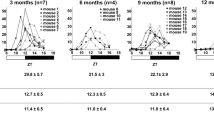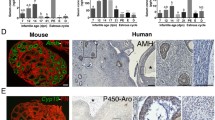Abstract
Reproductive aging results in declines in female fertility and in slight declines in baseline serum inhibins in humans. The authors tested the hypothesis that exogenous ovarian stimulation as a noninvasive dynamic test, by amplifying inhibin levels, can define more accurately than baseline serum inhibin levels the ovarian age of female rats. Female rats—young (immature, 26 days old), adult (65-75 days old), and reproductively aged (8- to 9-month-old retired breeders)—were administered pregnant mare’s serum gonadotropin to stimulate the ovaries and the serum inhibin A and inhibin B, and ovarian inhibins were measured. The young and adult females had at least a 4- to 10-fold increase in serum inhibin A and inhibin B after ovarian stimulation, but the reproductively aged females did not. Adult female serum inhibin measurements after stimulation at every stage of the estrous cycle revealed a consistent 4- to 5-fold increase in all stages, whereas the reproductively aged females did not. Western blot analyses of ovarian lysates were consistent with the serum inhibin level results and revealed that ovarian inhibin α, inhibin β A, and inhibin β B subunit levels in adult ovaries were elevated after ovarian stimulation but not in the reproductively aged ovaries. The data presented here demonstrate that young, adult, and reproductively aged female inhibin responses after exogenous ovarian stimulation were different. Inhibin measurement in serum after ovarian challenge in rats, therefore, is a noninvasive method that could be used to dissect ovarian function in aging in more detail.
Similar content being viewed by others
References
Practice Committee of the American Society for Reproductive Medicine. Aging and infertility in women. Fertil Steril. 2004; 82(suppl 1):S102–S106.
Arroyo A, Yeh J. Understanding the menopausal transition, and managing its clinical challenges. Sexuality, Reproduction and Menopause. 2005;3:12–17.
Yeh J, Seibel MM. Artificial insemination with donor sperm: a review of 108 patients. Obstet Gynecol. 1987;70: 313–316.
Lobo RA. Current concepts: potential options for preservation of fertility in women. N Engl J Med. 2005;353:64–73.
Lu JK, Anzalone CR, LaPolt PS. Relation of neuroendocrine function to reproductive decline during aging in the female rat. Neurobiol Aging. 1994;15:541–544.
Lu KH, Hopper BR, Vargo TM, Yen SS. Chronological changes in sex steroid, gonadotropin and prolactin secretions in aging female rats displaying different reproductive states. Biol Reprod. 1979;21:193–203.
Matt DW, Lee J, Sarver PL, Judd HL, Lu JK. Chronological changes in fertility, fecundity and steroid hormone secretion during consecutive pregnancies in aging rats. Biol Reprod. 1986;34:478–487.
Yeh J, Bowman MJ, Browne RW, Chen N. Reproductive aging results in a reconfigured ovarian antioxidant defense profile in rats. Fertil Steril. 2005;84(suppl 2):1109–1113.
Nass TE, LaPolt PS, Judd HL, Lu JK. Alterations in ovarian steroid and gonadotrophin secretion preceding the cessation of regular oestrous cycles in ageing female rats. J Endocrinol. 1984;100:43–50.
Woodruff TK, Mayo KE. Regulation of inhibin synthesis in the rat ovary. Annu Rev Physiol. 1990;52:807–821.
Merchenthaler I, Culler MD, Petrusz P, Negro-Vilar A. Rapid communication: immunocytochemical localization of inhibin in rat and human reproductive tissues. Mol Cell Endocrinol. 1987;54:239–243.
Meunier H, Cajander SB, Roberts VJ, et al. Rapid changes in the expression of inhibin alpha-, beta A-, and beta B-subunits in ovarian cell types during the rat estrous cycle. Mol Endocrinol. 1988;2:1352–1363.
Welt CK. Regulation and function of inhibins in the normal menstrual cycle. Semin Reprod Med. 2004;22:187–193.
Woodruff TK, Krummen L, McCray G, et al. In situ ligand binding of recombinant human 125I activin-A and recombinant human 125I inhibin-A to the adult rat ovary. Endocrinology. 1993;133:2998–3006.
Hsueh AJ, Dahl KD, Vaughan J, et al. Heterodimers and homodimers of inhibin subunits have different paracrine action in the modulation of luteinizing hormone-stimulated androgen biosynthesis. Proc Natl Acad Sci U S A. 1987;84:5082–5086.
Matzuk MM, Kumar TR, Shou W, et al.Transgenic models to study the roles of inhibins and activins in reproduction, oncogenesis, and development. Recent Prog Horm Res. 1996;51:123–154.
Pal D, Collins TJ, Parkening TA. Levels of alpha-inhibin in aging female mice. Biol Reprod. 1991;45:869–875.
Matt DW, Dahl KD, Sarkissian A, Sayles TE. Apparent absence of negative feedback in middle-aged persistent-estrous rats following luteinizing hormone-releasing hormone agonist treatment: relation to plasma inhibin and 17 beta-estradiol. Biol Reprod. 1993;48:333–339.
Hurwitz JM, Santoro N. Inhibins, activins, and follistatin in the aging female and male. Semin Reprod Med. 2004;22:209–217.
Klein NA, Illingworth PJ, Groome NP, McNeilly AS, Battaglia DE, Soules MR. Decreased inhibin B secretion is associated with the monotropic FSH rise in older, ovulatory women: a study of serum and follicular fluid levels of dimeric inhibin A and B in spontaneous menstrual cycles. J Clin Endocrinol Metab. 1996;81:2742–2745.
Danforth DR, Arbogast LK, Mroueh J, et al. Dimeric inhibin: a direct marker of ovarian aging. Fertil Steril. 1998;70:119–123.
Santoro N, Adel T, Skurnick JH. Decreased inhibin tone and increased activin A secretion characterize reproductive aging in women. Fertil Steril. 1999;71:658–662.
Anzalone CR, Hong LS, Lu JK, LaPolt PS. Influences of age and ovarian follicular reserve on estrous cycle patterns, ovulation, and hormone secretion in the Long-Evans rat. Biol Reprod. 2001;64:1056–1062.
Meredith S, Butcher RL. Role of decreased numbers of follicles on reproductive performance in young and aged rats. Biol Reprod. 1985;32:788–794.
Robertson DM, Hayward S, Irby D, et al. Radioimmunoassay of rat serum inhibin: changes after PMSG stimulation and gonadectomy. Mol Cell Endocrinol. 1988;58:1–8.
Fahy PA, Wilson CA, Beard AJ, Groome NP, Knight PG. Changes in inhibin-A (alpha-beta A dimer) and total alpha inhibin in the peripheral circulation and ovaries of rats after gonadotrophin-induced follicular development and during the normal oestrous cycle. J Endocrinol. 1995;147:271–283.
Palumbo A, Yeh J. In situ localization of apoptosis in the rat ovary during follicular atresia. Biol Reprod. 1994;51:888–895.
Jih MH, Lu JK, Wan YJ, Wu TC. Inhibin subunit gene expression and distribution in the ovaries of immature, young adult, middleaged, and old female rats. Endocrinology. 1993;132:319–326.
Sar M, Welsch F. Differential expression of estrogen receptor beta and estrogen receptor alpha in the rat ovary. Endocrinology. 1999;140:963–971.
Soodak LK, Behrman HR. Mitochondria mediate amplification of luteinizing hormone action by adenosine in luteal cells. Endocrinology. 1988;122:1308–1313.
Bicsak TA, Cajander SB, Vale W, Hsueh AJ. Inhibin: studies of stored and secreted forms by biosynthetic labeling and immunodetection in cultured rat granulosa cells. Endocrinology. 1988;122:741–748.
Bilezikjian LM, Vaughan JM, Vale WW. Characterization and the regulation of inhibin/activin subunit proteins of cultured rat anterior pituitary cells. Endocrinology. 1993;133:2545–2553.
Khan SM, Oliver RH, Yeh J. Epidermal growth factor receptor inhibition by tyrphostin 51 induces apoptosis in luteinized granulosa cells. J Clin Endocrinol Metab. 2005;90:469–473.
Jih MH, Wu TC. Altered regulation of pituitary luteinizing hormone secretion by GnRH and inhibin in the aged persistent-estrous female rat. Mech Ageing Dev. 1995;84:15–27.
Butcher RL. Effect of reduced ovarian tissue on cyclicity, basal hormonal levels and follicular development in old rats. Biol Reprod. 1985;32:315–321.
Sopelak VM, Butcher RL. Contribution of the ovary versus hypothalamus-pituitary to termination of estrous cycles in aging rats using ovarian transplants. Biol Reprod. 1982;27:29–37.
Edwards HE, Tweedie CJ, Terranova PF, Lisk RD, Wynne-Edwards KE. Reproductive aging in the Djungarian hamster, Phodopus campbelli. Biol Reprod. 1998;58:842–848.
Matt DW, Tedeschi ML, Sayles TE.Alterations in gonadotropin secretion in middle-aged persistent-estrous rats following LHRH agonist treatment. Neuroendocrinology. 1992;56:780–787.
McLachlan RI, Robertson DM, Burger HG, de Kretser DM. The radioimmunoassay of bovine and human follicular fluid and serum inhibin. Mol Cell Endocrinol. 1986;46:175–185.
Arai KY, Ohshima K, Watanabe G, Arai K, Uehara K, Taya K. Dynamics of messenger RNAs encoding inhibin/activin subunits and follistatin in the ovary during the rat estrous cycle. Biol Reprod. 2002;66:1119–1126.
Woodruff TK, Besecke LM, Groome N, Draper LB, Schwartz NB, Weiss J. Inhibin A and inhibin B are inversely correlated to follicle-stimulating hormone, yet are discordant during the follicular phase of the rat estrous cycle, and inhibin A is expressed in a sexually dimorphic manner. Endocrinology. 1996;137:5463–5467.
Author information
Authors and Affiliations
Corresponding author
Additional information
We thank Mary Joann Bowman, MS Jennifer Peresie, BS and Yuan Jing Liang, PhD, for their technical contributions to this study.
Rights and permissions
About this article
Cite this article
Yeh, J., Kim, B. Increasing Blunting of Inhibin Responses to Dynamic Ovarian Challenge Is Associated With Reproductive Aging in the Rat. Reprod. Sci. 14, 10–19 (2007). https://doi.org/10.1177/1933719106298186
Published:
Issue Date:
DOI: https://doi.org/10.1177/1933719106298186




